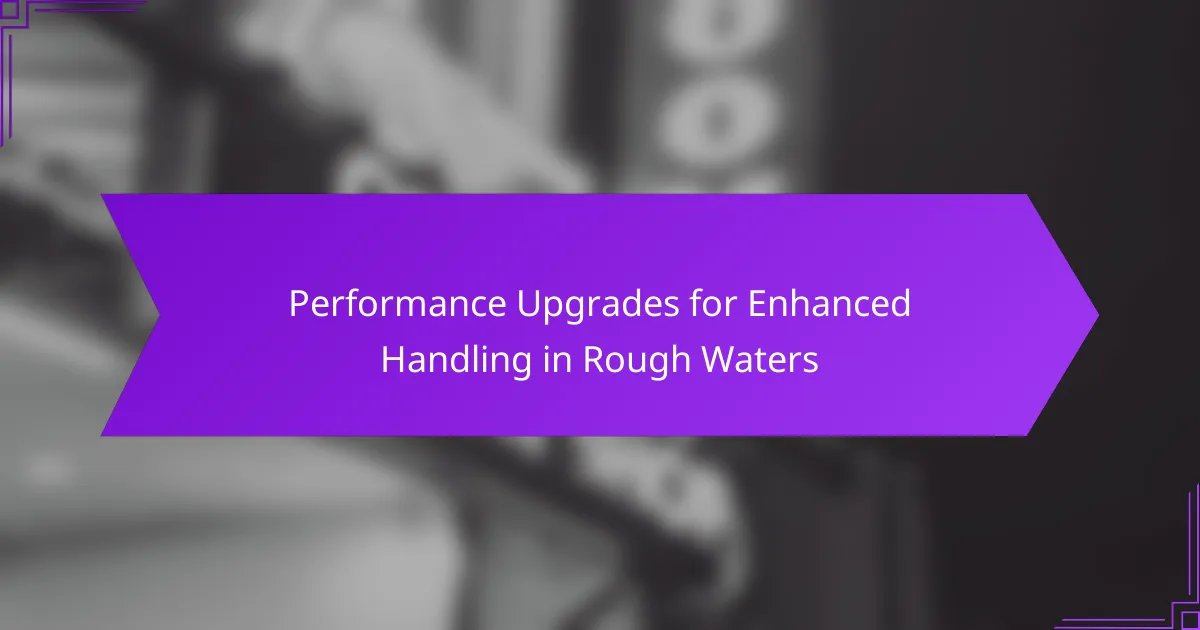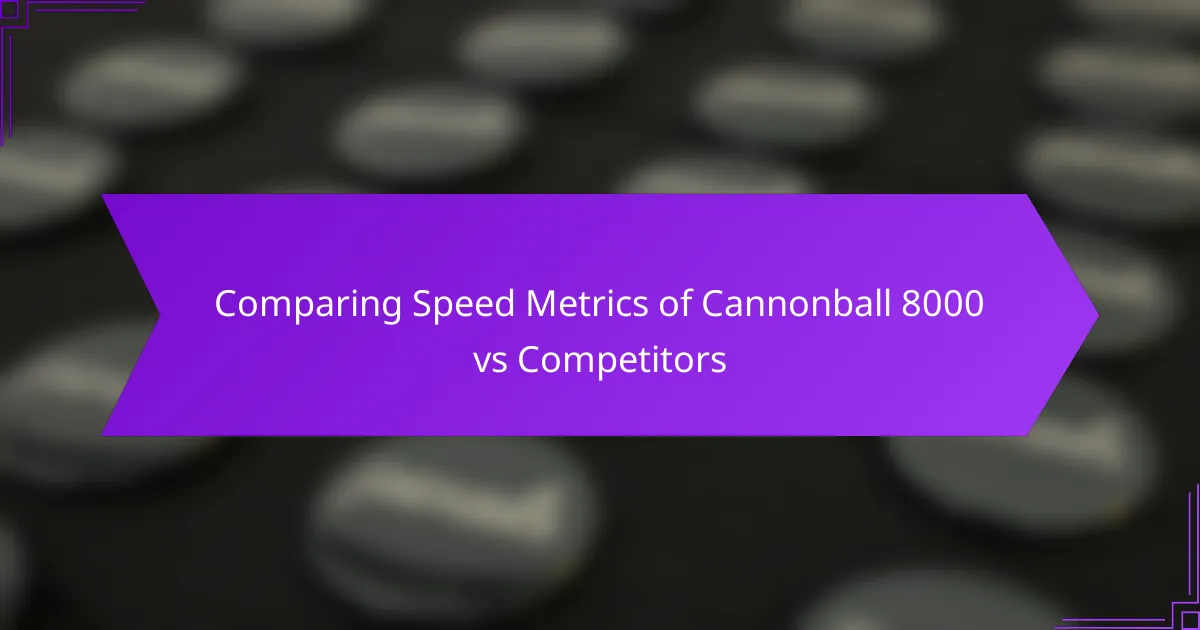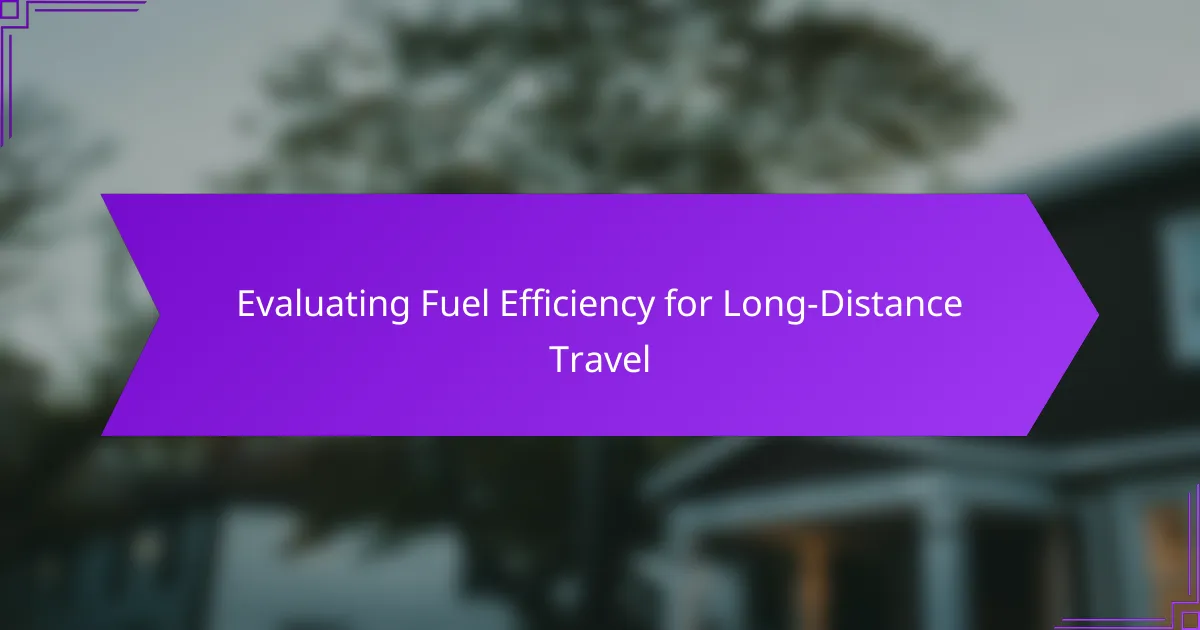Enhancing a vessel’s performance in rough waters is crucial for safety and efficiency, and several upgrades can significantly improve handling. Key modifications such as stabilizers, high-performance propellers, advanced hull designs, and upgraded shock absorbers work together to provide better balance, reduced drag, and increased ride comfort. These enhancements allow for smoother navigation through turbulent conditions, ensuring a more controlled experience on the water.
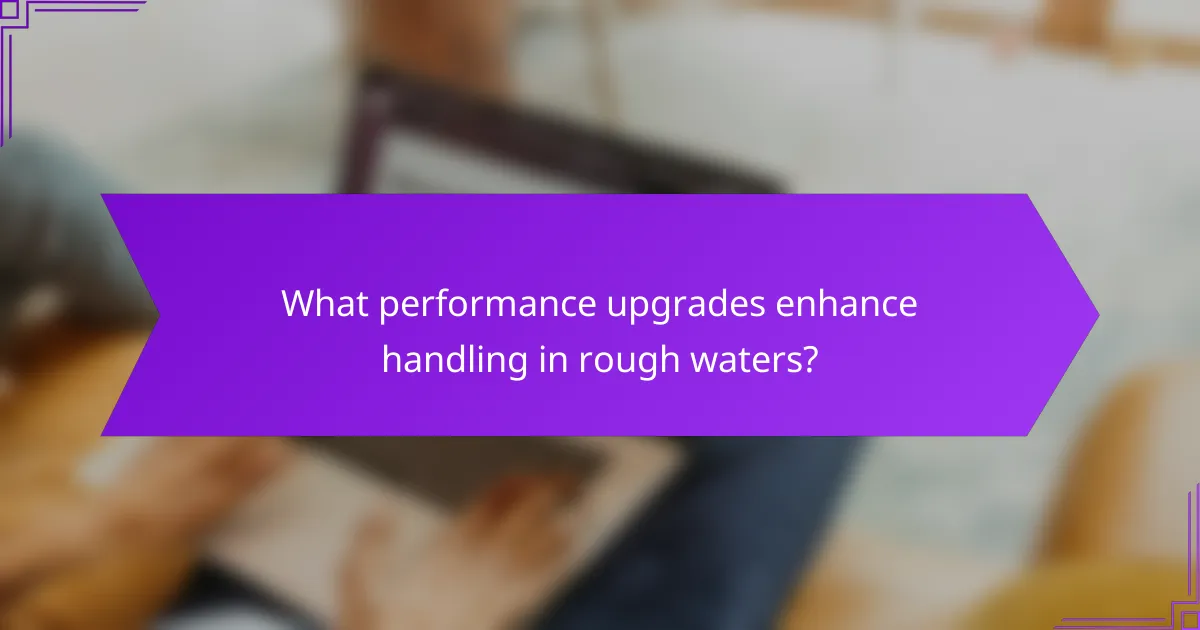
What performance upgrades enhance handling in rough waters?
Performance upgrades that enhance handling in rough waters include stabilizers, high-performance propellers, advanced hull designs, and upgraded shock absorbers. These modifications improve balance, thrust, drag reduction, and ride comfort, making navigation through turbulent conditions safer and more efficient.
Stabilizers for improved balance
Stabilizers are essential for maintaining balance in rough waters by reducing roll and pitch. They can be either active or passive systems, with active stabilizers adjusting automatically to changing conditions, while passive systems rely on fixed fins or keels. Choosing the right stabilizer depends on the vessel type and typical water conditions.
For example, a boat equipped with active stabilizers may experience a significant reduction in side-to-side motion, enhancing passenger comfort and safety. Consider the installation costs and maintenance requirements when selecting stabilizers, as these can vary widely.
High-performance propellers for better thrust
High-performance propellers are designed to provide better thrust and efficiency, especially in challenging conditions. These propellers often feature advanced materials and designs that optimize water flow, resulting in improved acceleration and maneuverability. When upgrading, consider the pitch and diameter of the propeller to match your vessel’s specifications.
For instance, a propeller with a higher pitch can increase speed but may reduce torque, affecting low-speed handling. It’s crucial to balance these factors based on your typical operating environment and desired performance outcomes.
Advanced hull designs for reduced drag
Advanced hull designs can significantly reduce drag, enhancing overall performance in rough waters. Hull shapes such as deep-V or catamaran designs are popular for their ability to cut through waves more effectively. These designs can help maintain speed and stability, even in choppy conditions.
When considering a hull upgrade, evaluate the trade-offs between speed, stability, and fuel efficiency. A well-designed hull can lead to lower fuel consumption and a more enjoyable boating experience, particularly in coastal or offshore environments.
Upgraded shock absorbers for smoother rides
Upgraded shock absorbers improve ride comfort by minimizing the impact of waves and turbulence. These systems can be hydraulic or pneumatic, with each offering different levels of responsiveness and comfort. Investing in high-quality shock absorbers can greatly enhance the experience for passengers and crew during rough conditions.
When selecting shock absorbers, consider the weight of your vessel and the typical sea states you encounter. A well-matched shock absorption system can reduce fatigue and improve safety by keeping the boat more stable and controllable in rough waters.

How do stabilizers improve boat handling?
Stabilizers enhance boat handling by reducing unwanted movements such as rolling and pitching, especially in rough waters. They work by counteracting the forces that cause these motions, leading to a more stable and controlled experience on the water.
Reduce roll and pitch in waves
Stabilizers are designed to minimize the roll and pitch of a boat when navigating through waves. They achieve this by using fins or gyroscopic systems that actively counterbalance the boat’s movements, allowing for smoother navigation even in choppy conditions.
For example, a boat equipped with active stabilizers can reduce roll by up to 50% compared to a non-stabilized vessel. This significant reduction helps maintain a level deck, making it easier to handle the boat and improving overall safety.
Enhance passenger comfort
By reducing roll and pitch, stabilizers greatly enhance passenger comfort on board. Passengers experience less motion sickness and can enjoy a more pleasant ride, which is particularly important during longer trips or in rough seas.
Comfort features may include adjustable stabilizer settings to cater to different sea conditions. This adaptability ensures that passengers remain comfortable, regardless of whether they are cruising in calm waters or navigating through turbulent waves.

What are the benefits of high-performance propellers?
High-performance propellers enhance a vessel’s handling in rough waters by improving speed, maneuverability, and fuel efficiency. These propellers are designed to optimize thrust and reduce drag, making them essential for navigating challenging marine conditions.
Increased speed and maneuverability
High-performance propellers significantly boost a boat’s speed and maneuverability, allowing for quicker responses to changing water conditions. The design of these propellers often features sharper blades and a more efficient pitch, which can lead to noticeable improvements in acceleration and turning capabilities.
For instance, a well-matched high-performance propeller can reduce the time it takes to reach planing speeds, enhancing overall handling. This is particularly beneficial in rough waters where swift adjustments are necessary to maintain stability and control.
Improved fuel efficiency
One of the key advantages of high-performance propellers is their ability to improve fuel efficiency. By optimizing the thrust-to-drag ratio, these propellers allow engines to operate more efficiently, which can lead to reduced fuel consumption during long trips.
Boat owners can expect fuel savings ranging from 10% to 20% compared to standard propellers, depending on the specific design and operating conditions. This not only lowers operational costs but also extends the range of the vessel, making it a practical choice for extended journeys in challenging environments.
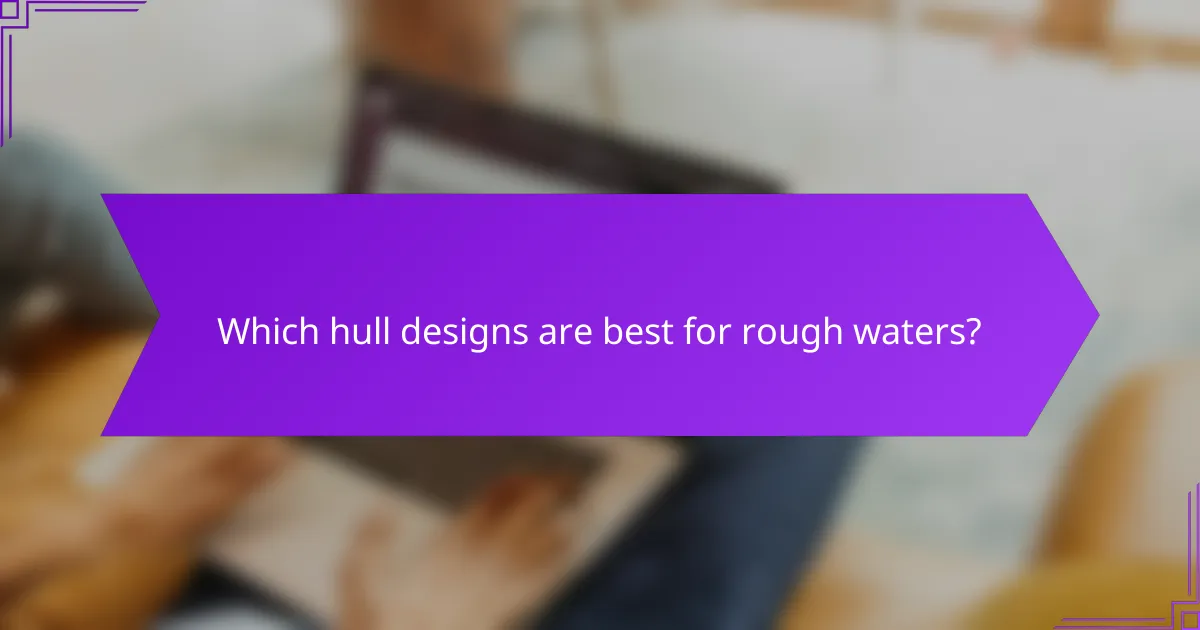
Which hull designs are best for rough waters?
For navigating rough waters, hull designs that excel include Deep-V and catamaran hulls. These designs enhance performance by improving stability and reducing the impact of waves.
Deep-V hulls for cutting through waves
Deep-V hulls feature a sharp, V-shaped bottom that allows boats to slice through waves effectively. This design minimizes the impact of rough water, providing a smoother ride and better handling in choppy conditions.
When considering a Deep-V hull, look for a steep angle of entry, typically between 20 to 30 degrees. This angle helps the boat rise over waves rather than slamming into them, which can be crucial for comfort and safety.
However, Deep-V hulls may require more power to achieve desired speeds, potentially leading to higher fuel consumption. It’s essential to balance performance needs with engine capacity and fuel efficiency.
Catamaran hulls for stability
Catamaran hulls consist of two parallel hulls, providing exceptional stability in rough waters. This design reduces rolling and pitching, making it easier to maintain control in challenging conditions.
Catamarans are often favored for their spaciousness and ability to remain level, which can enhance comfort for passengers. They can be particularly advantageous for recreational boating and fishing in turbulent environments.
While catamarans offer stability, they may not cut through waves as effectively as Deep-V hulls. Consider your primary use—if stability is paramount, a catamaran may be the better choice, especially for family outings or leisure activities.

What upgrades improve shock absorption?
Upgrading to advanced shock absorption systems can significantly enhance handling in rough waters. Key upgrades include hydraulic shock absorbers and adjustable suspension systems, which work together to minimize impact and improve stability.
Hydraulic shock absorbers for better impact handling
Hydraulic shock absorbers are designed to manage the energy from impacts more effectively than traditional systems. They use fluid dynamics to dampen shocks, allowing for smoother rides over rough surfaces. This technology can reduce wear on the vessel and improve passenger comfort.
When selecting hydraulic shock absorbers, consider factors such as the weight of your vessel and the typical conditions you encounter. Look for models that offer adjustable damping settings to tailor performance to specific water conditions. Regular maintenance is essential to ensure optimal performance and longevity.
Adjustable suspension systems for varying conditions
Adjustable suspension systems allow you to modify the stiffness and height of your vessel’s suspension based on current water conditions. This flexibility can enhance stability and control, especially in choppy waters. Systems that can be adjusted on-the-fly provide the best adaptability for changing environments.
When choosing an adjustable suspension system, consider ease of adjustment and the range of settings available. Some systems may offer electronic controls for quick changes, while others require manual adjustments. Regularly check the system for wear and ensure it is calibrated correctly for optimal performance.

What factors should be considered when selecting upgrades?
When selecting performance upgrades for enhanced handling in rough waters, consider the boat’s type and size, as well as the specific water conditions and typical usage. These factors will significantly influence the effectiveness and suitability of the upgrades you choose.
Boat type and size
The type and size of your boat are crucial in determining which upgrades will be most effective. For example, larger vessels may benefit from stabilizers or reinforced hulls, while smaller boats might require lightweight materials for better maneuverability. Always check compatibility with your boat’s specifications before proceeding.
Additionally, consider the boat’s intended use. A fishing boat may need different upgrades compared to a pleasure craft. Tailoring your upgrades to the specific type of boat ensures optimal performance in challenging conditions.
Water conditions and typical usage
Understanding the water conditions where you typically operate your boat is essential for selecting appropriate upgrades. If you frequently navigate choppy waters or rough seas, consider enhancements like deeper keels or specialized propellers designed for better grip and stability. These upgrades can significantly improve handling and safety.
Moreover, assess your typical usage patterns. For instance, if you often encounter strong currents or waves, investing in high-quality shock absorbers or trim tabs can provide better control and comfort. Always match your upgrades to the specific challenges you face on the water for the best results.

How do local regulations affect performance upgrades?
Local regulations significantly influence performance upgrades for enhanced handling in rough waters. These rules can dictate what modifications are permissible, ensuring safety and compliance with environmental standards.
Compliance with safety standards
Adhering to safety standards is crucial when considering performance upgrades. Many regions require that any modifications meet specific safety regulations to ensure the vessel remains seaworthy. For example, upgrades may need to comply with standards set by organizations like the American Boat and Yacht Council (ABYC) or the International Maritime Organization (IMO).
Before proceeding with any upgrades, check if your modifications will pass safety inspections. This could include ensuring that upgraded components are certified and that the overall vessel design remains stable and safe for operation in rough waters.
Restrictions on modifications in certain regions
Some areas impose restrictions on specific types of modifications to protect local ecosystems or maintain navigational safety. For instance, certain performance enhancements may be banned in environmentally sensitive zones to prevent damage to marine habitats.
It’s essential to research local laws before implementing upgrades. Contact local maritime authorities or consult with a marine professional to understand any limitations that may apply in your region, ensuring that your upgrades do not violate any regulations.
